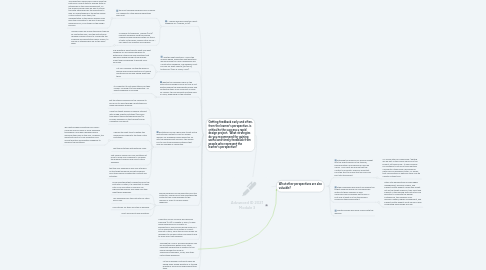
1. Getting feedback early and often, from the learner's perspective, is critical to the success a rapid design project. What strategies do you recommend for gaining useful and timely feedback from people who represent the learner's perspective?
1.1. "...explain precisely what you want feedback on" (Lisefski, 2019).
1.1.1. the most valuable feedback from a learner is in regards to if the learning objectives were met.
1.1.1.1. The objectives should very clearly show the path from current state to desired state as established in the needs assessment, so the learner should easily be able to follow this path established by the objectives to gain an understanding of the entire design of the content. From there, the representative of the learner audience will have the foundation to be able to provide feedback from, in all stages of the design process.
1.1.2. In regards to timeliness, Lisefski (2019) requests feedback using this phrase, “Please provide feedback within 24 hours. If that’s not possible, please notify me so I can adjust my schedule accordingly."
1.1.2.1. Learners who will review the project should be contacted early, and the instructional designer should be sure to coordinate the schedule and expectations early as well, to ensure all stakeholders are on the same page.
1.2. "Ask the right questions." Like in the analysis phase, asking the right questions would provide you more meaningful and constructive feedback. The designer must be clear on what "exactly [he/she is] testing for" (Dam & Siang, 2020).
1.2.1. Ask questions about exactly what you want feedback on and review feedback to determine if there are new questions that should be asked during future reviews. Adapt and be prepared to deviate from your plan
1.2.2. Let your reviewer contribute ideas by asking open ended questions or turning questions around and asking what they think.
1.3. identify the reviewers early on the instructional design process so time is not wasted finding the appropriate people and contacting them once a product is ready for review--this could waste multiple days or more, depending on the situation
1.3.1. it's important to set expectations for their review--scoping it to their expertise--so quality feedback is received
1.4. prototypes can be a good way to get actual instructional content in front of sample learners for feedback before going too far into the development process--this allows you to save time polishing materials that may be changed or ineffective.
1.4.1. get the steps scheduled on the calendar to force you to work through a prototype and make meaningful progress.
1.4.2. Have the target audience member interact with a high-fidelity prototype (and even throughout the prototyping process) to provide feedback on the training/course navigation and layout.
1.4.3. Choose the right tools to gather the feedback according to the type of the prototype.
1.4.3.1. "Be neutral when presenting your ideas." Using an online survey or email feedback techniques could help designers avoid imposing their bias on the user. However, the important point is to be "objective" and accept positive and negative feedback to enhance the prototype.
1.4.4. Test the prototype with extreme users.
1.4.5. Test several versions of your prototype at once to allow your audience to compare the different versions and solicit critical feedback.
1.4.6. test the user experience and user interface on the target audience and get feedback from them before creating the content and activities.
1.5. Before feedback can be expected from the instructor, learners must use everything the instructor has made available to the learners in order to receive useful feedback.
1.5.1. Once everything that is expected from the instructor is noted, it is important to make note of all due dates so learners can organize themselves and make sure they meet these deadlines.
1.5.2. Use feedback from the instructor as often as you can.
1.5.3. Use outlines for steps as often as possible.
1.5.4. Don't be afraid to ask questions.
1.6. Using the “scrum” process discussed by Piskurich (2015) in chapter 4 and 6, to gain quick feedback from a variety of perspectives. This process would allow for a lot of information to be obtain in a short amount of time, since this process allows for reviewers to see each other’s comments and to build upon that feedback.
1.7. Through the “scrum” process feedback can be simultaneously gather from other important perspective in addition to the learner perspective such as supervisors/managers, SMEs, and other instructional designers.
1.8. Let your reviewer contribute ideas by asking open ended questions or turning questions around and asking what they think.
2. What other perspectives are also valuable?
2.1. Although the learners can provide insight into the effectiveness of the training, having another ID professional could be useful. SME input will ensure that the content is accurate--which is important from the start to ensure that no errors are built into the project.
2.1.1. If a formal step for cleaning up / editing will be part of the overall lifecycle of the project, let them know. It may be easier for reviewers to let go of those editorial comments if they know a professional editor will be reviewing it later--or simply, that commenting on editorial items may be a waste of their time.
2.2. other individuals who aren’t necessarily the target audience group can and should be invited to these sessions as well; supervisors and managers get to have a first look at what is in the training and familiarize themselves with it
2.2.1. Other vital perspectives include higher management, decision-makers, and subject-matter experts. While they might not be the target audience, their input and support of the learning and instruction are essential to complete the design. Furthermore, the feedback from decision-makers, higher management, and subject-matter experts must be early upon completing each design process.
